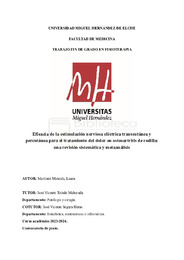Título :
Eficacia de la estimulación nerviosa eléctrica transcutánea y percutánea para el tratamiento del dolor en osteoartritis de rodilla: una revisión sistemática y metaanálisis |
Autor :
Martínez Miranda, Laura |
Tutor:
Toledo Marhuenda, José Vicente
Segura Heras, José Vicente |
Editor :
Universidad Miguel Hernández |
Departamento:
Departamentos de la UMH::Patología y Cirugía
Departamentos de la UMH::Estadística, Matemáticas e Informática |
Fecha de publicación:
2024-06-04 |
URI :
https://hdl.handle.net/11000/33654 |
Resumen :
Introducción: La osteoartritis de rodilla (KOA) es una enfermedad crónica degenerativa que afecta a
la articulación y sus tejidos, causando dolor, rigidez y limitaciones funcionales. Es una de las
principales causas de discapacidad a nivel mundial y su prevalencia está en aumento. Además, los
costes de tratamiento son elevados y se prevé un aumento en las artroplastias de rodilla. Los
tratamientos actuales incluyen métodos farmacológicos y no farmacológicos como la estimulación
eléctrica nerviosa transcutánea y percutánea.
Objetivos: Evaluar si las técnicas de estimulación eléctrica nerviosa transcutánea (TENS) y
percutáneas son eficaces por sí solas para el tratamiento del dolor en pacientes con KOA.
Métodos: Se realizó una búsqueda electrónica de la literatura científica, siguiendo la pregunta PICO,
en las bases de datos PubMed y EMBASE de ensayos clínicos aleatorizados y revisiones sistemáticas.
La herramienta Cochrane Risk of Bias se empleó para evaluar el riesgo de sesgo y se estableció la
calidad metodológica mediante la escala PEDro.
Resultados: De los 10 ensayos seleccionados, sólo uno incluía tanto un grupo de TENS como un
grupo de electroacupuntura (EA), mientras que en los otros estudios: tres ensayos incluyeron EA, un
estudio estimulación periostal y los otros cinco ensayos: TENS.
Conclusión: Con los resultados obtenidos en este metaanálisis, no podemos afirmar que estas terapias
sean eficaces para el manejo del dolor en KOA, lo que sugiere que se necesita más investigación.
Introduction: Knee osteoarthritis (KOA) is a chronic degenerative disease that affects the joint and
its tissues, causing pain, stiffness, and functional limitations. It is one of the leading causes of
disability worldwide, and its prevalence is increasing. Additionally, treatment costs are high, and an
increase in knee arthroplasties is anticipated. Current treatments include both pharmacological and
non-pharmacological methods such as transcutaneous and percutaneous electrical nerve stimulation.
Objectives: To evaluate whether transcutaneous (TENS) and percutaneous electrical nerve
stimulation techniques are effective on their own for the treatment of pain in patients with KOA.
Methods: An electronic search of the scientific literature was conducted, following the PICO
question, in the PubMed and EMBASE databases for randomized clinical trials and systematic
reviews. The Cochrane Risk of Bias tool was used to assess the risk of bias, and methodological
quality was established using the PEDro scale.
Results: Of the 10 selected trials, only one included both a TENS group and an electroacupuncture
(EA) group, while the other studies included: three trials with EA, one study with periosteal
stimulation (PST), and the remaining five trials with TENS.
Conclusion: Based on the results obtained from this meta-analysis, we cannot assert that these
therapies are effective for managing pain in KOA, suggesting that further research is needed.
|
Palabras clave/Materias:
Osteoarthritis, knee
Transcutaneous Electric Nerve Stimulation
Percutaneous Electric Nerve Stimulation
Electroacupuncture
Pain |
Área de conocimiento :
CDU: Ciencias aplicadas |
Tipo de documento :
info:eu-repo/semantics/bachelorThesis |
Derechos de acceso:
info:eu-repo/semantics/openAccess
Attribution-NonCommercial-NoDerivatives 4.0 Internacional |
Aparece en las colecciones:
TFG - Fisioterapia
|
 La licencia se describe como: Atribución-NonComercial-NoDerivada 4.0 Internacional.
La licencia se describe como: Atribución-NonComercial-NoDerivada 4.0 Internacional.
.png)
